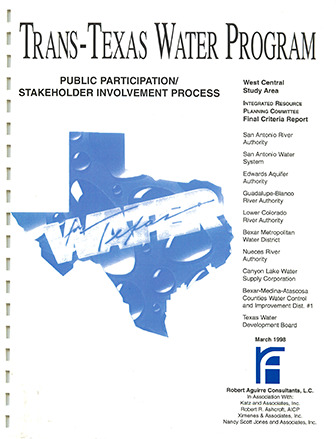Trans-Texas Water Program West Central Study Area Integrated Resource Planning Committee Final Criteria Report Public Participation / Stakeholder Involvement Process

| Author | Robert Aguirre Consultants, LC, Katz and Associates, Inc, Robert R Ashcroft, AICP, Dethman and Associates, Inc, and Nancy Scott Jones and Associates, Inc / San Antonio River Authority, San Antonio Water System /EAA / Guadalupe-Blanco River Authority / Lower Colorodo River Authority / Bexar Metropolitan Water District / Nueces River Authority /Canyon Lake Water Supply Corp / Bexar-Medina-Atascosa Counties Water Control and Improvement Dist #1 / Texas Water Development Board |
| Year | 1998 |
| Description | Note: This report is included because of its possible historical value. It has been replaced by more recent plans. Input of public and stakeholders in the Trans-Texas Water Program West Central Study Area. |
| Publisher | Robert Aguirre Consultants, LC |
| Location | West Central Texas |
| Cover | View Download |
| File | View Download |
| Summary |
|
Note: This report is included because of its possible historical value. It has been replaced by more recent plans. The Trans-Texas Water Program was initiated as a regional water planning process by the Texas Water Development Board to identify the most cost-effective and environmentally sensitive strategies for meeting the current and future water needs of southeast, south-central, west-central and north-central Texas. Each of these areas was designated as a study region. This report relates to the West Central Study Area of the Trans-Texas Water Program which was formed in 1993 (see map of study region, p. 3.). The West Central Study Area comprises thirty-two (32) counties west of the Brazos River and includes the Guadalupe-Blanco, San Antonio and Lower Colorado River basins, part of the Nueces River basin, the Edwards Aquifer and part of the Carrizo-Wilcox Aquifer. Initially, the program was to be carried out in three phases: 1) Program Initiation/Conceptual Planning; 2) Feasibility Studies; and 3) Implementation. The Senate Bill 1 process superseded the Trans-Texas Water Program process and consequently, feasibility studies and the implementation phases were not completed…. Committee Conclusions Economic Water Quality Fairness Feasibility Efficiency Flexibility Compatibility Reliability Environment Recommendations |
Search for Documents
Advance Search
Explore EAA's Scientific Reports
- All Reports
- Groundwater Movement
- Geomorphology and Caves
- Weather Modification
- Geology
- Water Use and Conservation
- Geochemistry
- Water Resources Planning and Management
- Floods and Drought
- Water Quality
- Climatology
- Surface Water / Groundwater Relationship
- Biology
- Springs, Groundwater Discharge
- Archaeology
- RZ Protection
- Aquifer Levels
- Remote Sensing
- Precipitation
- Overview Studies
- Modeling
- Hydrology and Hydrogeology
- History
- Groundwater Recharge, Recharge Zone
